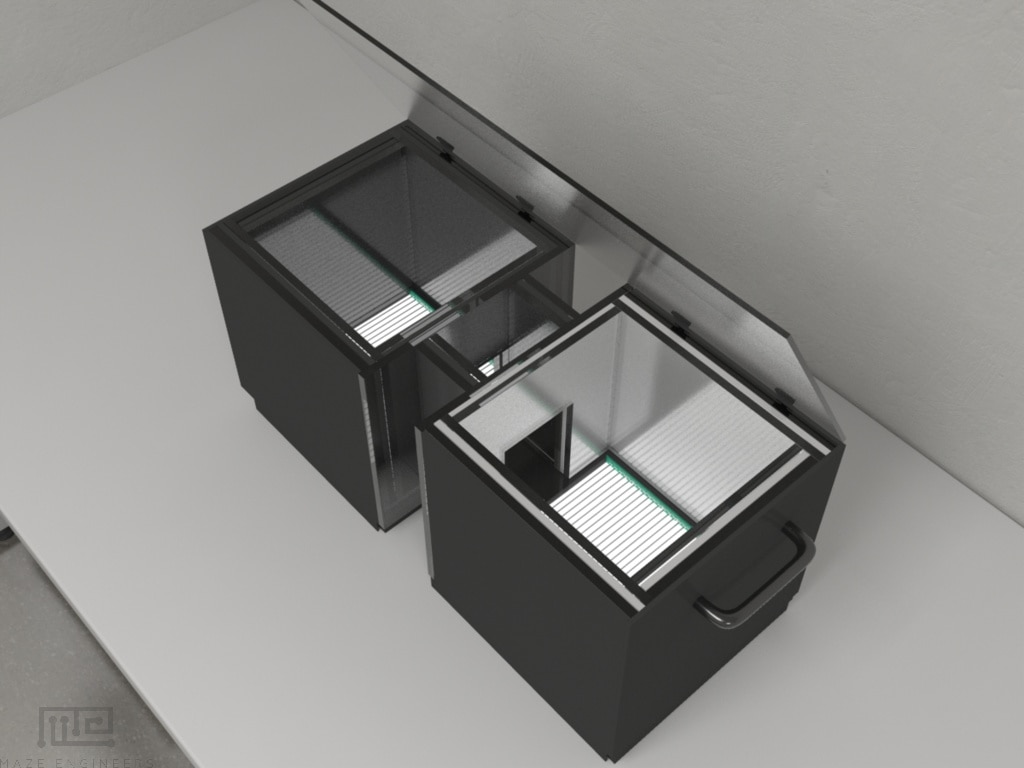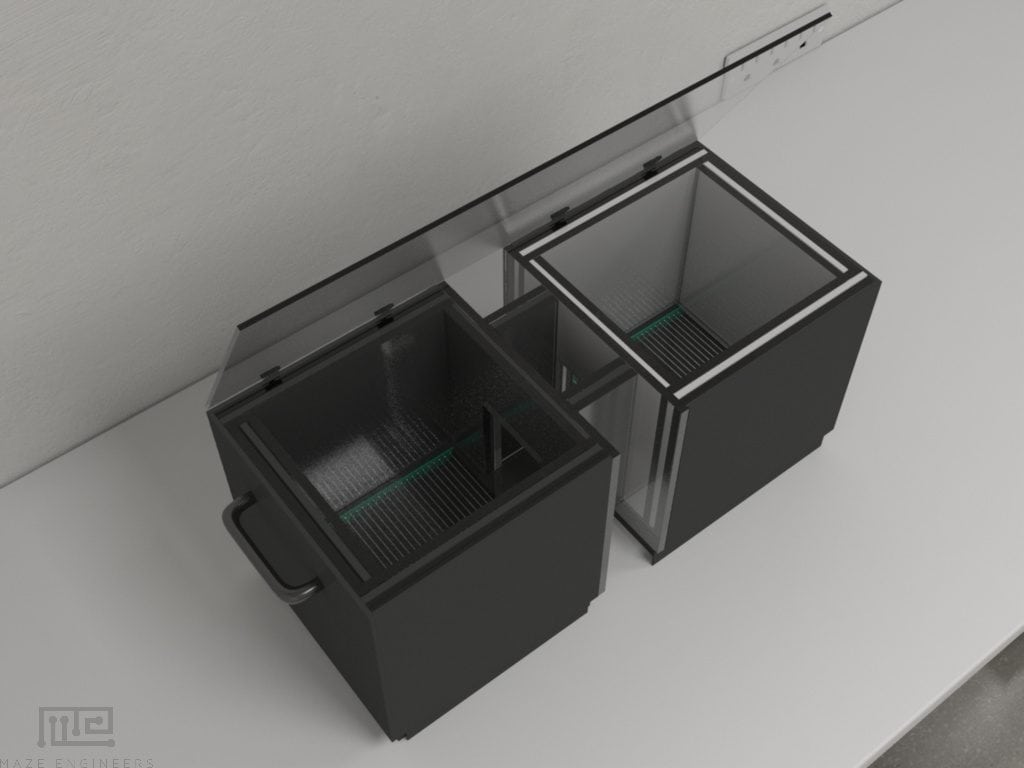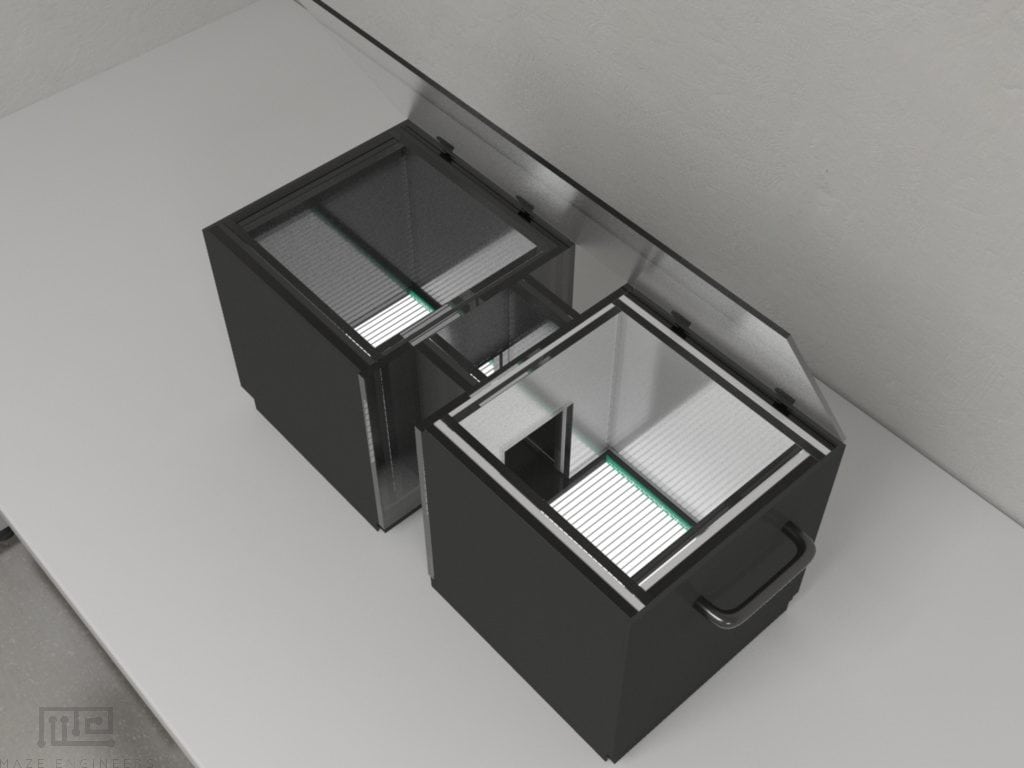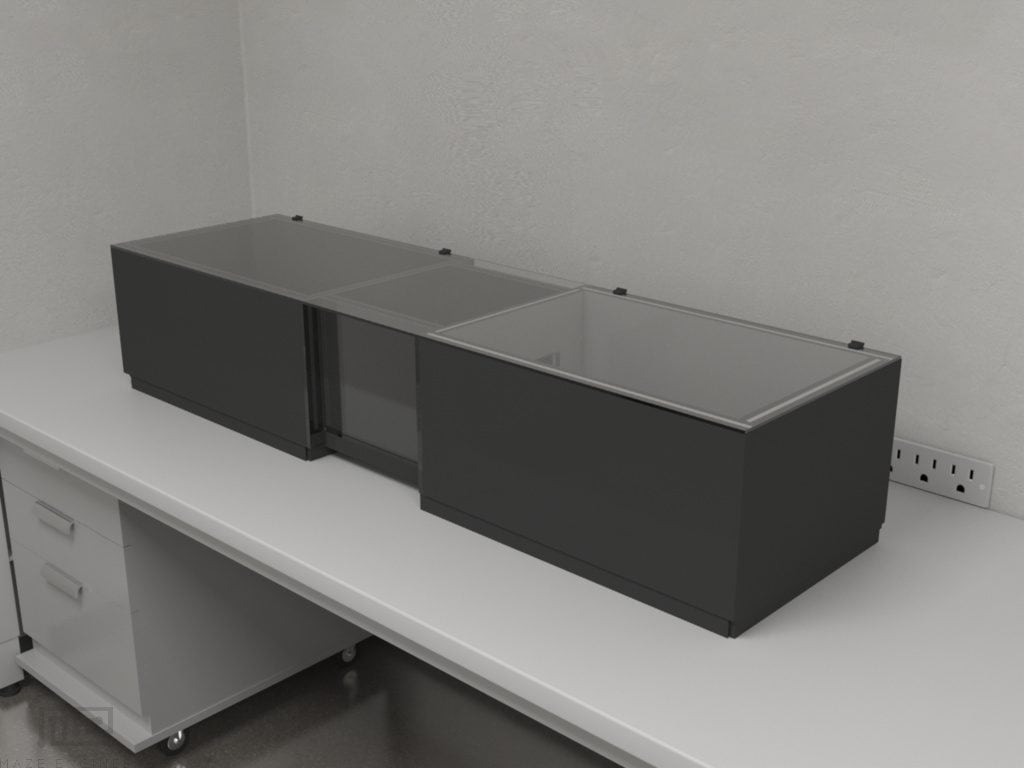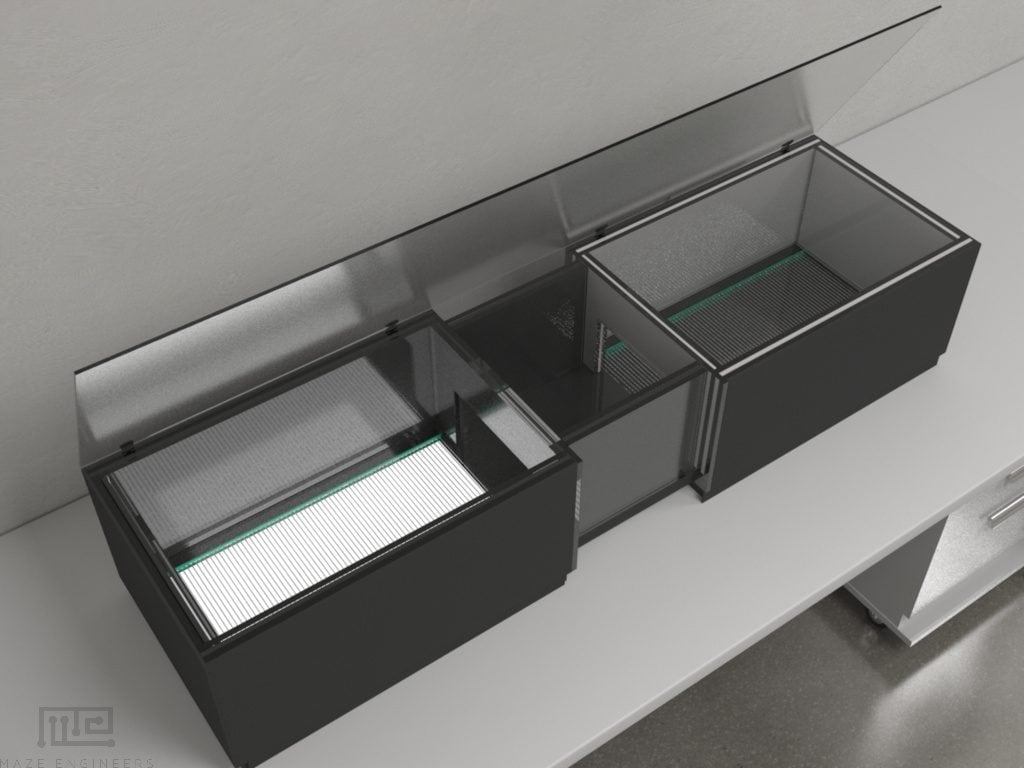Description
- The MazeEngineers automated conditioned place preference consists of two acrylic compartments of the same size interconnected by a central corridor with the color of your choice.
- Each chamber functions independently including animal location detection, light controls, and shock controls. Removable acrylic plating allows for contexts during the CPP experiment
- Automated doors can be included in your order
- The entire chamber includes a removable top including clear acrylic.
Features
Contextual Plates
- Easy to replace acrylic plates with black, white, and even striped contexts
Automated IR Detection
- Automated detection with highly sensitive IR sensor mechanisms built between chambers. Allows for automated counting detection. Works in addition to augmented video tracking services such as Noldus Ethovision
Light Cues
- 2 Independent light controls
- Ordered as a feature
Shock
- 0.1-4.0mA in 0.1mA steps
- DC Current.
- Removable Grid
- 2 Independent Shock grid control
Take advantage of Neuralynx, Ethovision Integration, SMS and Email integration with the Conductor Science Software. No I/O Boxes Required
Price & Dimensions
Mouse 3 Chamber CPP
$ 5900
Per Month- Three chambers
- Contextual plates: White, black, striped
- 2 dual control shock grids
- 2 dual control lights
- (Optional addon) Sound
Rat 3 Chamber CPP
$ 6400
Per Month- Three chambers
- Contextual plates: White, black, striped
- 2 dual control shock grids
- 2 dual control lights
- (Optional addon) Sound
Documentation
Introduction
The Automated Conditioned Place Preference Apparatus is an adapted version of the Conditioned Place Preference Test. Automated IR detection, independent light controls, and independent shock grid controls are the features that modify the standard Conditioned Place Preference apparatus into an automated version. The apparatus consists of two equal-sized acrylic compartments interconnected by a smaller central corridor.
The Conditioned Place Preference test is a behavioral model to examine the rewarding and aversive effects of drugs. During the test, rodents’ preference toward one compartment is assessed by measuring the time spent in both compartments during the pre-conditioning phase. Next, the conditioning phase is conducted, where the initially preferred compartment is paired with a control substance, such as saline, and the non-preferred compartment is paired with a drug. The subjects are injected with either saline or the drug and then restricted to the associated compartment on alternate days. The post-conditioning phase is then conducted following the conditioning phase without injecting the saline or the drug. This phase is identical to the pre-conditioning phase and examines whether the subject’s developed a conditioned place preference towards the drug in which their initial preference changed after being conditioned. The two compartments also contain distinctive cues, allowing the animals to learn to associate the cues with the reinforcer (Prus, James, & Rosecrans, 2009).
The Automated Conditioned Place Preference Apparatus is equipped with lights in both chambers that can be independently controlled to serve as cues. Additionally, white, black, and striped acrylic plates can be equipped in the compartments to serve as contexts during the task. Furthermore, the compartments also include a removable shock grid that administers shocks, which can also serve as reinforcement.
Apparatus and Equipment
The Automated Conditioned Place Preference Apparatus consists of three acrylic compartments or chambers. Two compartments serve as the experimental compartments, which are interconnected by the third compartment, which is smaller in size. A clear removable acrylic lid covers all three compartments.
The apparatus includes white, black, and striped contextual plates, two dual control lights, and two dual control shock grids. The shock grids are removable and provide currents between 0.1-4.0mA in 0.1mA steps. Highly sensitive IT sensor mechanisms are built between chambers for automated detection. This allows automated counting detection, which can work in addition to video tracking systems such as the Noldus EthoVision XT. Each chamber functions independently, including light controls, shock controls, and animal location detection.
Conduct Science also offers speakers for sound cues, which can be equipped in the experimental chambers. Moreover, the compartments can also be equipped with automated guillotine doors upon request.
Training Protocol
Thoroughly clean all compartments and bottom trays with isopropyl alcohol (70%) and dry them with a paper towel before each trial.
The following is a sample protocol to study conditioned place preference in rodents:
- Habituation
Transport the subjects from the animal housing room to the test room thirty minutes before the experiment. Allow the subject to habituate to the apparatus for a few minutes before the experiment.
- Pre-conditioning Phase
The pre-conditioning phase is conducted to determine the subject’s baseline preference.
Place the subject in the apparatus with all the doors kept open. Allow it to move in all three chambers for 10 minutes freely. Remove the subject from the apparatus and return it to its home cage.
- Conditioning Phase
Start trials a day after pre-conditioning sessions. Pair the initially preferred compartment with saline solution and the non-preferred compartment with the drug.
Inject the subjects with the drug on the first day. Place the subject in the compartment paired with the drug for 30 minutes. Remove the subject from the apparatus. On the next day, inject the subject with saline and place it in the saline-paired compartment for 30 minutes. Conduct saline and drug trials on alternate days for 10 days.
- Post-conditioning Phase
Conduct post-conditioning trials a day following the last conditioning session. Conduct trials in the same manner as the pre-conditioning phase to observe if the subject developed a conditioned place preference.
Literature Review
Investigation of the role of orexin receptors in modulating stress and inducing drug priming reinstatement
Ebrahimiam et al. (2016) investigated the role of the orexin-1 receptor (OX1R) and orexin-2 receptor (OX2R) antagonists in modulating stress and inducing drug priming and relapse using a reinstatement procedure of conditioned place preference. Intradentate gyrus (DG) administration of SB334867 was utilized as the OX1R antagonist, whereas TCS OX2 29 was used as an OX2R antagonist. One hundred and forty-four adult male albino Wistar rats were bilaterally implanted by cannulas into the DG.
The Conditioned Place Preference Apparatus was used to induce conditioned place preference. The subjects received daily doses of 5 mg/kg morphine subcutaneously during the conditioning phase conducted over three days. Following the conditioned place preference task, extinction of morphine-rewarding properties was conducted on the same apparatus. During extinction, the time spent in each compartment was analyzed. Trials were conducted until the subjects had conditioning scores on two subsequent days, which were similar to the scores during the pre-conditioning phase.
Following twenty-four hours after achieving the extinction criterion, the subjects were tested for drug priming-induced reinstatement and Force Swim Stress-induced reinstatement. A priming dose of 1 mg/kg of morphine was administered for drug priming-induced reinstatement, whereas exposure to the Forced Swim Test was used for forced swim stress-induced reinstatement. The subjects were then placed back into the conditioned place preference apparatus ten minutes after morphine dosage or the forced swim stress test to analyze whether they displayed drug-seeking behaviors. It was observed that the forced swim stress-induced the reinstatement of seeking behaviors. Moreover, the effect of intra-DG Administration of OX1R and OX2R antagonists on the reinstatement of morphine-seeking behaviors was also investigated. Results indicated that the administration of the antagonists lessened drug priming-induced reinstatement; however, they were insignificant in forced swim stress-induced reinstatement.
Investigation of oxycodone-induced conditioned place preference
Niikura, Ho, Kreek, and Zhang (2013) investigated oxycodone-induced conditioned place preference and its effect on the locomotion of adolescent (4 weeks old) and adult (10 weeks old) mice. The conditioned place preference apparatus had a white compartment with a stainless-steel mesh floor and a black compartment with a stainless-steel grid rod floor. One compartment was paired with saline, and the other compartment was paired with oxycodone. The mice were divided into four groups of seven mice in each group. Each group was administered a different dose of oxycodone: 0, 0.3, 1, and 3 mg/kg. The subjects were injected with oxycodone and saline on alternate days of the conditioning phase. Results indicated that conditioned place preference was developed by the adult mice at the lowest oxycodone dose (0.3 mg/kg). However, this was not observed in adolescent mice. Observation of locomotor activity revealed that locomotion activity increased in the adult mice at oxycodone doses of 1 and 3 mg/kg. However, the adolescent mice only displayed an increase in locomotor activity at the 3 mg/kg dose.
Data Analysis
The following parameters can be observed using the Automated Conditioned Place Preference Apparatus:
- The time the subject spent in each compartment during the pre-conditioning phase
- The distance the subject traveled in each compartment in the pre-conditioning phase.
- The time the subject spent in each compartment during the post-conditioning phase
- The distance the subject traveled in each compartment in the post-conditioning phase.
- The locomotor activity of the subject during the conditioning phase.
Strengths
The following parameters can be observed using the Automated Conditioned Place Preference Apparatus:
- The time the subject spent in each compartment during the pre-conditioning phase
- The distance the subject traveled in each compartment in the pre-conditioning phase.
- The time the subject spent in each compartment during the post-conditioning phase
- The distance the subject traveled in each compartment in the post-conditioning phase.
- The locomotor activity of the subject during the conditioning phase.
Limitations
Novelty-seeking behaviors by the subject can potentially affect results despite habituating the subjects to the procedure before conditioning. The experimenters should be trained to handle the animals with care since stressful handling can weaken conditioning. The strain, age, or gender of the subjects can influence results.
Summary
- The Automated Conditioned Place Preference Apparatus is an adapted version of the Conditioned Place Preference Test.
- The apparatus comprises two equal-sized acrylic compartments interconnected by a smaller central corridor. It includes automated IR detection, independent light controls, and independent shock grid controls.
- The apparatus is available with removable white, black, and striped acrylic contextual plates.
- The Automated Conditioned Place Preference Apparatus makes the conditioned place preference protocol easier and less time-consuming.
- It can be used to examine the rewarding and aversive effects of drugs and in studies investigating drug relapse.
References
- Prus, A. J., James, J. R., & Rosecrans, J. A. (2009). Conditioned Place Preference. In J. J. Buccafusco (Ed.), Methods of Behavior Analysis in Neuroscience. (2nd ed.). CRC Press/Taylor & Francis.
- Ebrahimian, F., Naghavi, F. S., Yazdi, F., Sadeghzadeh, F., Taslimi, Z., & Haghparast, A. (2016). Differential roles of orexin receptors within the dentate gyrus in stress- and drug priming-induced reinstatement of conditioned place preference in rats. Behavioral neuroscience, 130(1), 91–102. https://doi.org/10.1037/bne0000112
- Niikura, K., Ho, A., Kreek, M. J., & Zhang, Y. (2013). Oxycodone-induced conditioned place preference and sensitization of locomotor activity in adolescent and adult mice. Pharmacology, biochemistry, and behavior, 110, 112–116. https://doi.org/10.1016/j.pbb.2013.06.010

